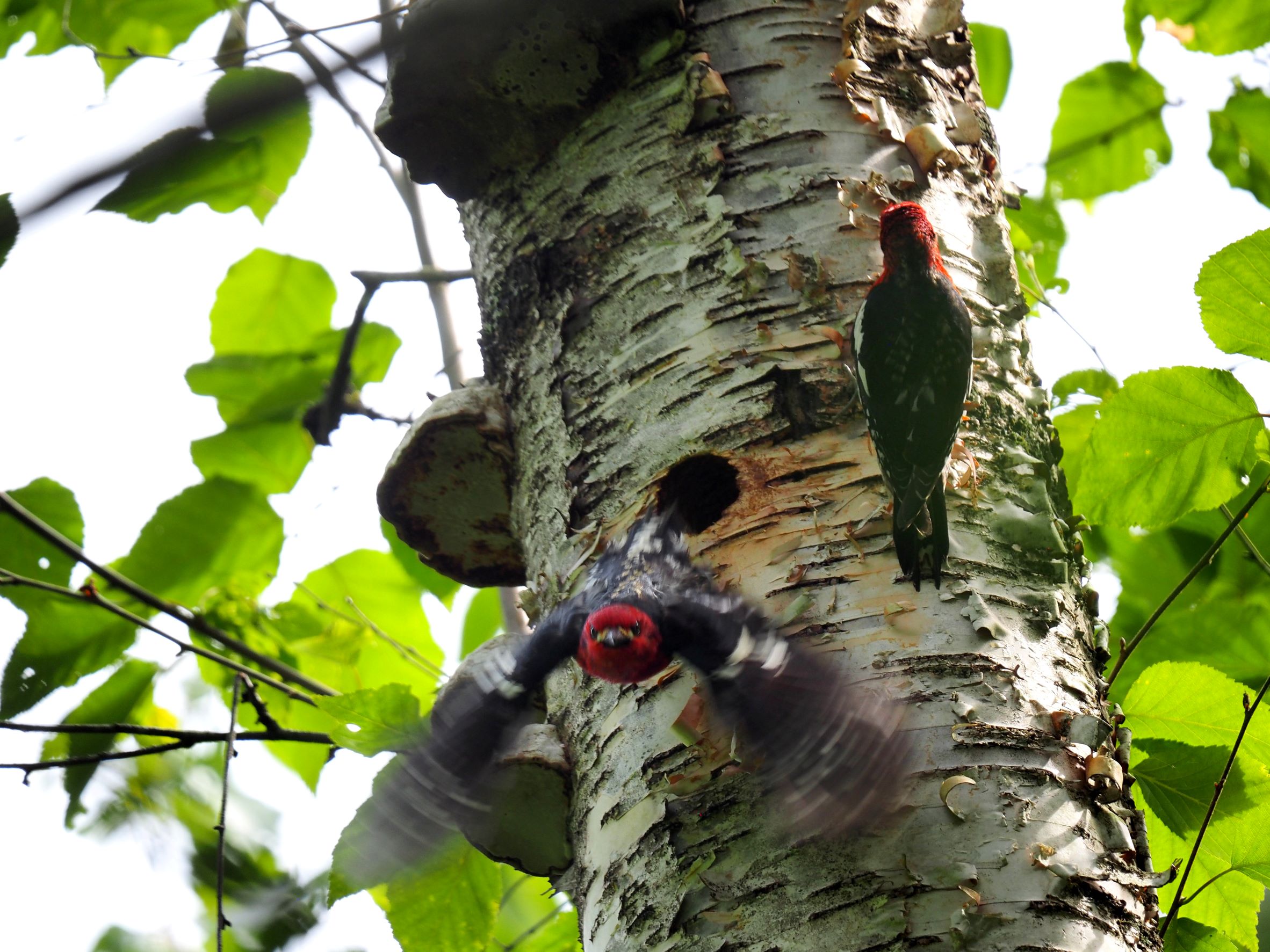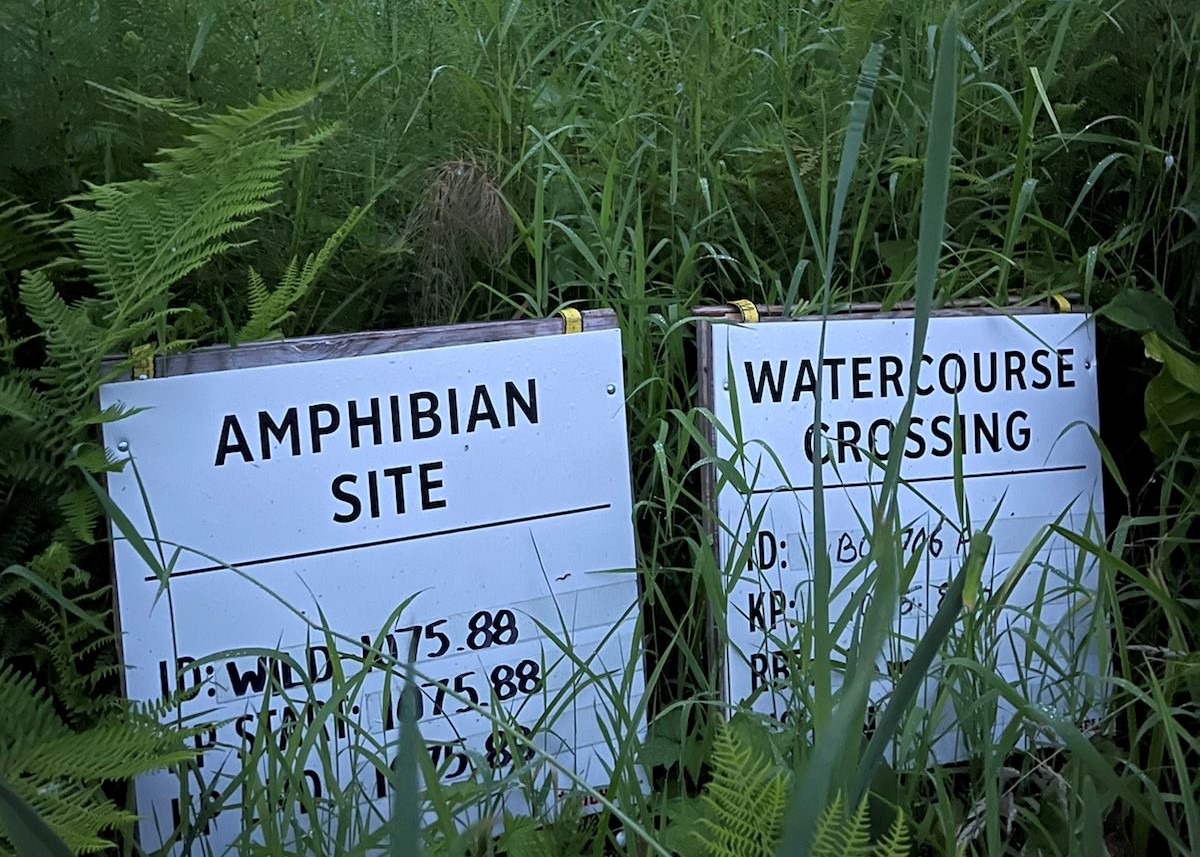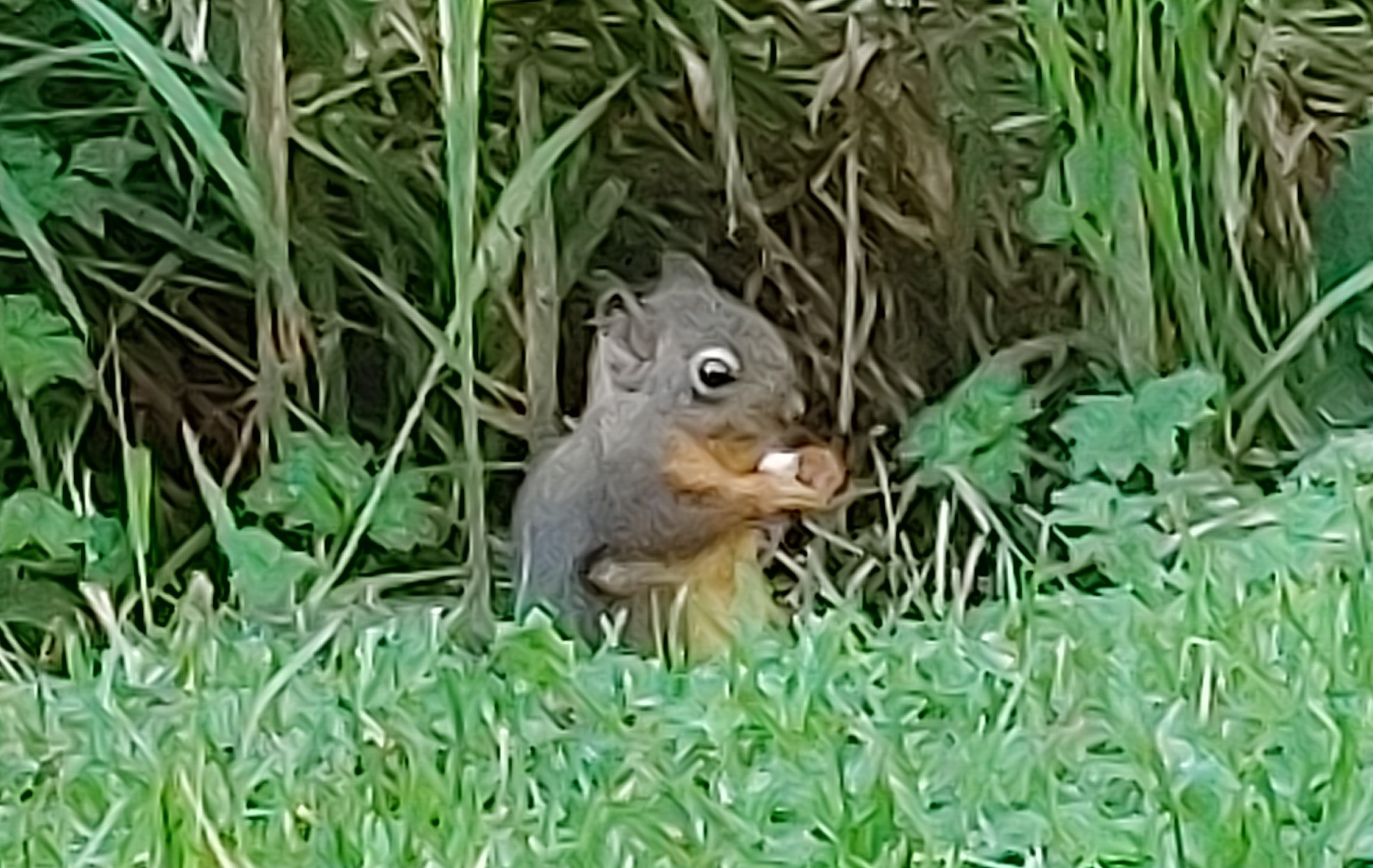
West Coast Environmental Law’s Environmental Dispute Resolution Fund (EDRF) provides legal and funding support for individuals and groups using the law to protect the places, people and species they care about – like Cara Cornell, a Fraser Valley resident working to prevent harm to local wetlands and wildlife caused by Trans Mountain construction.
On May 20th, 2022, Cara Cornell and her husband were startled by the arrival of trucks and heavy machinery outside their home in Bridal Veil Falls, near Chilliwack, BC. Workers had come to begin clearing land for construction of the Trans Mountain Pipeline Expansion (TMX), which passes right behind Cara’s Fraser Valley property – impacting local waterways and a wetland area that provides habitat for a variety of birds, squirrels, salamanders and many other wildlife species.
Cara knew at once that the impending tree cutting would mean trouble for these animals, especially the significant population of migratory nesting birds that live in the wetland. She enjoyed watching them from her kitchen window: woodpeckers, robins, finches, hummingbirds, cedar waxwings, red-breasted sapsuckers, swallows and more. She was shocked that the workers had just shown up, with no prior notification, and started cutting trees during nesting season.
So she sprung into action, hoping to halt the work to protect the nesting birds. She found the supervisor in charge and began asking questions, and to her surprise, she was told that biologists who swept the site earlier did not find any nests.
Despite Cara’s objections – and despite the fact that a robin was clearly observed at the time flying around the construction site – the site was cleared, removing mature trees, shrubs and grasses. It was a much larger area than she’d expected, and the wetland across the road was set to meet the same fate.
“I have to speak for the birds and the animals. I see them every day. This is their home too.” – Cara Cornell

Photo: Cara Cornell
Determined to protect this neighbouring marsh from being destroyed, Cara started digging into Trans Mountain’s regulatory documents and connected with like-minded nature advocates in the region, including Sara Ross of the Community Nest Finding Network (CNFN), Lynn Perrin of PIPE UP Network, Ian Stephen of the WaterWealth Project, and Peter Vranjkovic of Protect the Planet. Their research revealed that the area in question was highlighted as a “location of interest” for barn owls and coastal giant salamanders in Trans Mountain’s Environmental Plan, and the activities they witnessed there raised concerns about whether construction was complying with environmental laws and/or conditions of the pipeline’s approval.
The wetland contained an array of dense shrubs and lush tall grasses, and a large treed canopy with mature coniferous and deciduous trees that provided a safe home for birds throughout the year. Even the Trans Mountain Environmental Plan designated the site as a “rare ecological community” of western red cedar, sword fern and skunk cabbage. With water flowing in from Popkum Creek, and shelter from Mount Cheam, the area is also critical habitat for at-risk species like the coastal giant salamander and the barn owl.

Photo: Donna Clark, Community Nest-finding Network
With some help from the CNFN, Cara and her group discovered an active red-breasted sapsucker nest within the wetland site that was set to be cut. This was not the first time that nests had been found at TMX work sites – CNFN members have discovered nests at multiple construction sites along the pipeline route that were about to be cleared, or where cutting had already begun. Cutting trees during nesting season is generally prohibited under Canada’s Migratory Birds Regulations as well as Section 34 of BC’s Wildlife Act.
Despite it being nesting season, and the permit requirement saying construction should happen in the fall and winter to help protect salamanders and owls, the crew was poised to clear cut the wetland on June 6, 2022. Cara intercepted the supervisor and advised them that there were nesting birds on site, which prompted a temporary halt to construction.
This reprieve provided some space for the group to delve more deeply into the legal issues, and consider their options for protecting the wetland. That’s where West Coast Environmental Law came in.
With funding support from West Coast’s Environmental Dispute Resolution Fund (EDRF), Cara and her group were able to hire a private lawyer as well as independent biologists to conduct surveys, gather information and help figure out their next steps.
Working with lawyer Ian Moore, they attempted to contact Trans Mountain directly to seek more information about their planned construction activities in the wetland, and to negotiate changes in those plans to help preserve the ecosystem. Meanwhile, the group submitted a Notice of Motion to the Canadian Energy Regulator (CER), arguing that TMX construction activities in the area were in non-compliance with multiple laws and conditions intended to mitigate harm to wildlife – including the Migratory Birds Convention Act; certain conditions contained in the project’s approval by the National Energy Board and the BC government; and Trans Mountain’s own Environmental Plan.
The Notice of Motion demanded that Trans Mountain provide more transparent information about their construction activities, and replace the registered biologists who had failed to identify nests. It also called for the pipeline construction in this area to use horizontal directional drilling (HDD), which would lessen the harm to the ecosystem by drilling beneath the marsh instead of bulldozing the wetland.
In addition to the Notice of Motion, Cara and the group took action in other ways: reaching out to local media to raise public awareness about the habitat destruction, and contacting other decision-makers including the Fraser Valley Regional District, BC’s Minister of Forests, and the BC Oil and Gas Commission. Sadly, their appeals to rescind TMX’s permits and protect the wildlife in the area were not heeded.

Baby Douglas squirrells and their parents no longer have the wetland for their habitat. Photo: Cara Cornell.
As the group learned, gaps in information, monitoring and enforcement have allowed Trans Mountain’s activities to skirt environmental rules and conditions – with few consequences, even when regulators are provided with evidence of possible non-compliance.
For instance, Cara and her peers submitted an Access to Information (ATI) request regarding Trans Mountain’s application for permits under BC’s Wildlife Act. It took five months for the group to receive the information requested, and the process re-emphasized the challenges of public accountability under BC’s environmental legislation. It showed that while TMX had validly obtained its permits from the BC government, those permits included conditions requiring more detailed information and on-the-ground surveys to identify and mitigate harm to species – and it’s unclear whether, when or how those on-the-ground surveys took place, or what was found.
Getting detailed information from the project proponents or regulators about on-site surveys, or specific actions being taken to protect species, is often very difficult. In any case, by the time the group received their ATI results, the site had been cleared, which meant it was too late to make use of the information they received.
According to the 2016 NEB Assessment Report for TMX, Environment and Climate Change Canada identified the Fraser Valley as an area “where the continuing loss or degradation of wetlands has reached critical levels,” and recommended implementing measures to reduce the loss of wetland functions as much as possible.
Despite all this, and after all of the hard work by community members, the wetland site was eventually cleared to make way for TMX. But this determined group of individuals was able to save numerous nesting birds by preventing TMX from clear cutting the wetland in the middle of migratory bird nesting season – which was no easy feat. There were also a number of mature conifers and deciduous trees that Cara believes were saved due to their efforts. Plus, this work connected Cara with a network of nature advocates who aren’t giving up their fight to save the species they care about.
Cara’s experience working to protect nature in her community highlighted a number of gaps in protection for species in BC, as well as the difficulties associated with challenging a major infrastructure project like TMX.
First, there was a lack of transparency and limited public access. For example, Trans Mountain denied the group’s request to have an independent biologist enter the wetland to complete an assessment of the species present, which made it difficult for local residents to understand just what was at stake, and how the construction activities would impact the land, water and species in their neighbourhood.
This case also highlighted the lack of effective legal tools and enforcement to protect species and ecosystems, and the urgent need for the BC government to follow through on its commitment to enact biodiversity legislation.
Now, Cara is joining the growing chorus of voices across the province calling on BC to enact overarching biodiversity and ecosystem health legislation. This new law, co-developed with Indigenous peoples, would apply to all sectors, and could help ensure that human activities are pursued in a way that respects nature’s limits.
Cara feels that the establishment of an unambiguous and “no-nonsense” biodiversity law should start with critical habitat mapping across the province, as emphasized in a recent Wilderness Committee / Sierra Club BC report by biologist Jared Hobbs.
In Cara’s words:
“Critical habitat mapping and biodiversity laws could have saved the wetland. Other sensitive ecosystems that are biodiverse are just as crucial and should be mapped as well. Protecting wildlife and healthy ecosystems is just as important as helping species at risk recover.”
Through the EDRF, West Coast is fortunate to work with environmental defenders like Cara from all over BC, to tackle challenges big and small – from saving local wetlands, to prosecuting polluters and advocating for strong laws to safeguard nature.
Speaking up for the environment isn’t always easy, but these types of grassroots efforts are needed more than ever as our communities and ecosystems confront the worsening crises of climate change and biodiversity loss.
To all the environmental defenders out there making a difference for land, air, water and wildlife in your communities, thank you!
In the face of environmental challenges, it may sometimes feel like individuals and communities don’t have any power to affect change – but you do, and you don’t have to face these challenges alone.
To learn more about the legal support provided through the EDRF and West Coast’s Access to Justice program, check out our Frequently Asked Questions. If you are dealing with an environmental issue and wish to speak to a lawyer, contact us at legalaid@wcel.org.
“Files like Cara’s demonstrate the challenge of holding proponents accountable in the face of the complexity and sheer weight of documentation associated with a project like Trans Mountain. TMX was often unwilling to explain what they were doing or what they were obligated to do, but to fully understand everything a member of the public would need to hire their own biologists and other professionals, which is an unfair burden to place on members of the public affected by a project.” – Ian Moore, Lawyer
“We couldn’t have done it without WCEL. I am forever grateful for West Coast Environmental Law helping to point us in the right direction, and helping with the financial support, which allowed us to hire a lawyer and hire biologists.” – Cara Cornell, EDRF Client
Top photo: Sara Ross, Community Nest-finding Network